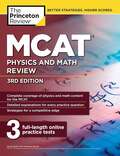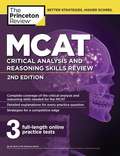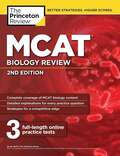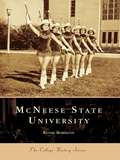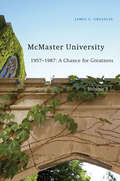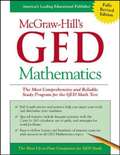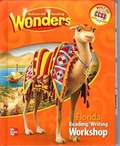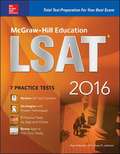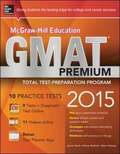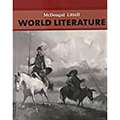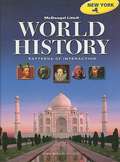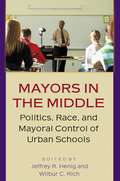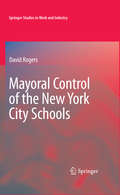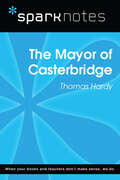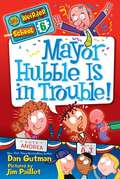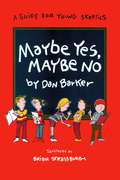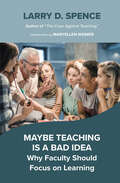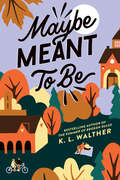- Table View
- List View
Mcdougal Littell Literature: The Interactive Reader Plus
by Mcdougal LittellThe InterActive Reader Plus is a new kind of literature book. As you will see, this book helps you become an active reader. It is a book to mark on, to write in, and to make your own. You can use it in class and take it home.
Mcdougal Littell Literature and Language, Orange Level (Grade #9)
by James Marshall Arthur N. Applebee Judith A. Langer Andrea B. BerrnúdezThis book is unlike any textbook you have ever used. It is based on a unique philosophy--that what you bring to this book is just as important as what the book brings to you. This means that your own experiences become the basis for your involvement with the literature and activities. The special features in Literature and Language promote this relationship between you and the text.
Mcat Physics And Math Review, 3rd Edition
by The Princeton The Princeton ReviewMCAT Physics and Math Review, 3rd Edition (Graduate School Test Preparation)
Mcat Critical Analysis And Reasoning Skills Review
by The Princeton The Princeton ReviewMake sure you’re studying with the most up-to-date prep materials! Look for the newest edition of this title, The Princeton Review MCAT Critical Analysis and Reasoning Skills Review, 3rd Edition (ISBN: 9780593516249, on-sale November 2022). Publisher's Note: Products purchased from third-party sellers are not guaranteed by the publisher for quality or authenticity, and may not include access to online tests or materials included with the original product.
Mcat Biology Review, 2nd Edition
by The Princeton The Princeton ReviewMake sure you’re studying with the most up-to-date prep materials! Look for the newest edition of this title, The Princeton Review MCAT Biology Review, 3rd Edition (ISBN: 9780593516232, on-sale November 2022). Publisher's Note: Products purchased from third-party sellers are not guaranteed by the publisher for quality or authenticity, and may not include access to online tests or materials included with the original product.
McNeese State University
by Kathie BordelonSurrounded by live oaks and azaleas, McNeese State University has served Southwest Louisiana for over sixty years. Founded in 1939 by area businessmen and cattlemen, the university has grown and thrived side by side with the city of Lake Charles. Alumni, faculty, staff, and students alike take pride in the heritage of their evolving university, and the city embraces the school as a treasured landmark of the community. McNeese State University began as Lake Charles Junior College, a division of Louisiana State University. Just one year after its inception, the name was changed to John McNeese Junior College in honor of one of the area's foremost pioneer educators. In 1950 the name was changed to McNeese State College when four-year status was obtained, and university status was achieved in 1970. The campus has enjoyed phenomenal expansion, from its initial three buildings constructed on the site of the town's Poor Farm to the vibrant and sprawling 68 buildings and over 500 acres it consists of today. Scenes of student life--in classrooms, dormitories, club meetings, and at athletic events--as well as memorable events throughout the course of the school's history are the focus of this visual journey. Students are pictured during lighter moments, enjoying the camaraderie of their classmates, but their serious side is also displayed during such trials as the disastrous hurricane that forced over 1,000 refugees to shelter on campus and the period during World War II when the campus became the headquarters of the Louisiana Maneuvers. Notable alumni of McNeese State include Dr. Cecil Cyrus Vaughn, a pioneer in cardiovascular medicine and artificial transplant surgery; Sheryl L. Abshire, one of the first five inductees into the National Teacher Hall of Fame and a Christa McAuliffe Fellow; and Andre Dubus, a critically acclaimed writer.
McMaster University, Volume 3: A Chance for Greatness
by James G. GreenleeIn 1957, McMaster was a small Baptist enclave of traditional higher learning on the western outskirts of Hamilton. Thirty years later it was home to the only nuclear reactor on a Commonwealth campus and had cultivated a thriving engineering program and a world-class medical school. In the third volume of the university's history, James Greenlee illuminates the core ideas, driving ambitions, and occasionally sharp conflicts that marked this startling transition. Greenlee offers a tightly focused study of the planning, people, and events that gave McMaster its distinctive and bold personality. At the heart of these developments stood President Harry Thode, whose master plan forged a research-intensive institution of medium size, but one capable of surpassing the largest institutions in carefully selected fields. Despite dramatic ups and downs, the remarkable persistence of this model is the key to understanding modern McMaster. For readers interested in the problems of mass education in a democratic age, the origins of revolutionary approaches to medical training, or the tangled relations among a university, its community, and the province, this volume, like the McMaster leaders it follows, has a story to tell.
McMaster University, Volume 3: 1957-1987
by James G. GreenleeIn 1957, McMaster was a small Baptist enclave of traditional higher learning on the western outskirts of Hamilton. Thirty years later it was home to the only nuclear reactor on a Commonwealth campus and had cultivated a thriving engineering program and a world-class medical school. In the third volume of the university's history, James Greenlee illuminates the core ideas, driving ambitions, and occasionally sharp conflicts that marked this startling transition. Greenlee offers a tightly focused study of the planning, people, and events that gave McMaster its distinctive and bold personality. At the heart of these developments stood President Harry Thode, whose master plan forged a research-intensive institution of medium size, but one capable of surpassing the largest institutions in carefully selected fields. Despite dramatic ups and downs, the remarkable persistence of this model is the key to understanding modern McMaster. For readers interested in the problems of mass education in a democratic age, the origins of revolutionary approaches to medical training, or the tangled relations among a university, its community, and the province, this volume, like the McMaster leaders it follows, has a story to tell.
McGraw-Hill's GED Mathematics: The Most Comprehensive and Reliable Study Program for the GED Math Test
by Jerry HowettMcGraw-Hill's GED Mathematics guides you through the GED preparation process step-by-step. A Pretest helps you determine your strengths and weaknesses so you can create a study plan to fit your needs. The following chapters introduce you to math concepts on which hundreds of GED questions are based. Then check your understanding of these ideas with the Posttest, presented in the GED format. You can then see how ready you are for the big exam by taking the full-length Practice Test. McGraw-Hill's GED Mathematics includes: *Clear instructions to show you how to use number grids and coordinate plane grids. *Instruction and frequent practice with the Casio /x-260 calculator. *Problem-solving strategies to help you understand word problems. *Easy-to-follow lessons to develop essential math skills in whole numbers, decimals, fractions, percents, ratios, data analysis, geometry, and algebra.
McGraw-Hill Reading Wonders: Florida Reading Writing Workshop, Grade 3
by McGraw-Hill Education<P>"With your Florida Reading/Writing Workshop you will: <br>Talk About New Ideas; <br>Read and Reread Exciting Literature; <br>Read and Reread Informational Text; <br>Look for Text Evidence; <br>Access Complex Text; <br>Be an Expert Writer; and <br>Do Your Own Research."
McGraw-Hill Education LSAT 2016
by Russ Falconer Drew D. JohnsonMcGraw-Hill Education: LSAT focuses on the fundamental concepts tested on the exam as well as the reasoning and analytical skills necessary to overcome common traps.
McGraw-Hill Education GMAT Premium 2015
by Ryan Hackney James Hasik Stacey RudnickMcGraw-Hill Education: GMAT Premium's innovative approach guides you through a comprehensive preparation program that you can tailor to your academic lifestyle. Obsessed with practice tests? You'll find 10 full-length practice exams via this book and online. Like to study on your laptop? Use the online practice tests. Wondering how to organize your studies? Customize your study plan with the Test Planner app. Are you a better visual learner? We have 11 online coaching videos to help.
McDougal Littell World Literature
by Arthur N. Applebee Andrea B. Bermúdez Sheridan BlauNIMAC-sourced textbook
McDougal Littell World History, Patterns of Interaction
by Larry S. Krieger Roger B. Beck Linda BlackNIMAC-sourced textbook
McDougal Littell Science Grade 8 (North Carolina Edition)
by Mcdougal LittelA science book that introduces the young future scientist to the systematic study of the nature from molecular particles to the human body to the whole universe. it's divided science into different fields: Life science Earth science Physical science
McDougal Littell Literature: Pennsylvania, Grade 8
by McDougal LittelMcDougal Littell Literature Pennsylvania: Student Edition Grade 8 2008
McDougal Littell Literature [Grade 9]
by Arthur N. Applebee Jim Burke Douglas Carnine Yvette Jackson Judith A. Langer Robert J. Marzano Mary Lou Mccloskey Donna M. Ogle Carol Booth Olson Lydia Stack Carol Ann Tomlinson Robert T. Jimenez Janet Allen et al.NIMAC-sourced textbook
Mayors in the Middle: Politics, Race, and Mayoral Control of Urban Schools
by Jeffrey R. Henig Wilbur C. RichDesperate to jump-start the reform process in America's urban schools, politicians, scholars, and school advocates are looking increasingly to mayors for leadership. But does a stronger mayoral role represent bold institutional change with real potential to improve big-city schools, or just the latest in the copycat world of school reform du jour? Is it democratic? Why have efforts to put mayors in charge so often generated resistance along racial dividing lines? Public debate and scholarly analysis have shied away from confronting such issues head-on. Mayors in the Middle brings together, for students of education policy and urban politics as well as scholars and school advocates, the most thoughtful and original analyses of the promise and limitations of mayoral takeovers of schools. Reflecting on the experience of six cities--Baltimore, Boston, Chicago, Detroit, Cleveland, and Washington, D.C.--ten of the nation's leading experts on education politics tackle the question of whether putting mayors in charge is a step in the right direction. Through the case studies and the wide-ranging essays that follow and build upon them, the contributors--Stefanie Chambers, Jeffrey R. Henig, Kenneth J. Meier, Jeffrey Mirel, Marion Orr, John Portz, Wilbur C. Rich, Dorothy Shipps, and Clarence N. Stone--begin the process of answering questions critical to the future of inner-city children, the prospects for urban revitalization, and the shape of American education in the years to come.
Mayoral Control of the New York City Schools
by David RogersThis book examines the political dynamics of the governance overhaul and how the management styles of Mayor Bloomberg and School Chancellor Klein affect its design and implementation in the Mayor's first term. The trend toward mayoral governance is happening in other large cities, stimulated in part by business leaders, mayors, and states concerned about how the schools contribute to declining global competitiveness and chronic social and economic problems of inner cities.
Mayor of Casterbridge (SparkNotes Literature Guide Series)
by SparkNotesMayor of Casterbridge (SparkNotes Literature Guide) by Thomas Hardy Making the reading experience fun! Created by Harvard students for students everywhere, SparkNotes is a new breed of study guide: smarter, better, faster. Geared to what today's students need to know, SparkNotes provides: *Chapter-by-chapter analysis *Explanations of key themes, motifs, and symbols *A review quiz and essay topicsLively and accessible, these guides are perfect for late-night studying and writing papers
Mayor Hubble Is in Trouble! (My Weirder School #6)
by Dan GutmanElection day is right around the corner, and guess who's running for class president? A.J. and Andrea! Mayor Hubble is going to teach the kids all the ins and outs of politics, and every vote counts. Who's going to win? Who's going to lose? And who's going to kiss a baby? Ew, gross!
Maybe Yes, Maybe No: A Guide For Young Skeptics (Maybe Guides)
by Dan BarkerIn today's media-flooded world, there is no way to control all of the information, claims, and enticements that reach young people. The best thing to do is arm them with the sword of critical thinking.Maybe Yes, Maybe No is a charming introduction to self-confidence and self-reliance. The book's ten-year-old heroine, Andrea, is always asking questions because she knows "you should prove the truth of a strange story before you believe it.""Check it out. Repeat the experiment. Try to prove it wrong. It has to make sense." writes Barker, as he assures young readers that they are fully capable of figuring out what to believe, and of knowing when there just isn't enough information to decide. "You can do it your own way. If you are a good skeptic you will know how to think for yourself."
Maybe Teaching is a Bad Idea: Why Faculty Should Focus on Learning
by Larry D. SpenceDeep and lasting learning results when we teach human brains in ways responsive to how they’re structured and how they function, which is not how we imagine they work or wish they would work. This book proposes a radical restructuring of teaching so that it conforms to how people learn. Spence maintains that teaching cannot and should not be aimed at transferring knowledge from teacher brains into student brains. In his words: “Decades of experience have made perfectly clear that this approach frustrates teachers, bores students, and results in minimal learning.”This is a book that challenges—it will poke and prod your thinking. The author writes near the end of Chapter 4, “I wanted to write a book that asked real questions and explored possible answers. I am not concerned that you agree with my answers or ideas, but I fervently hope the questions I’m raising will lead you to questions about habitual teaching practices and the resulting failure of students to learn.”
Maybe Meant to Be
by K. L. WaltherIf Charlie and Sage are meant to be, why can't Sage stop kissing Charlie's brother?And why can't Charlie stop thinking about kissing the new boy at school?Everyone at the Bexley School believes that Sage Morgan and Charlie Carmichael are meant to be. Even though Charlie seems to have a new girlfriend every month, and Sage has never had a real relationship, their friends and family all know it's just a matter of time until they realize that they are actually in love. When Luke Morrissey shows up on campus his presence immediately shakes things up. Charlie and Luke are drawn to each other the moment they meet, giving Sage the opportunity to spend time with Charlie's twin brother, Nick.But Charlie is afraid of what others will think if he accepts that he has much more than a friendship with Luke. And Sage fears that if she lets things with Nick get too serious too quickly, they won't be able to last as a couple outside of high school and miss their chance at forever. The duo will need to rely on each other and their lifelong friendship to figure things out with the boys they love.

